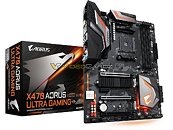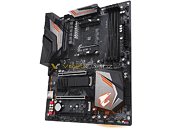- Joined
- Oct 9, 2007
- Messages
- 47,324 (7.51/day)
- Location
- Hyderabad, India
| System Name | RBMK-1000 |
|---|---|
| Processor | AMD Ryzen 7 5700G |
| Motherboard | ASUS ROG Strix B450-E Gaming |
| Cooling | DeepCool Gammax L240 V2 |
| Memory | 2x 8GB G.Skill Sniper X |
| Video Card(s) | Palit GeForce RTX 2080 SUPER GameRock |
| Storage | Western Digital Black NVMe 512GB |
| Display(s) | BenQ 1440p 60 Hz 27-inch |
| Case | Corsair Carbide 100R |
| Audio Device(s) | ASUS SupremeFX S1220A |
| Power Supply | Cooler Master MWE Gold 650W |
| Mouse | ASUS ROG Strix Impact |
| Keyboard | Gamdias Hermes E2 |
| Software | Windows 11 Pro |
GIGABYTE's upcoming flagship socket AM4 motherboard, the X470 Aorus Gaming 7, eclipsed two other models by the company based on the AMD X470 chipset, the X470 Aorus Gaming 5 /WiFi, and the X470 Aorus Ultra Gaming, pictured below. The X470 Aorus Gaming 5 has two variants based on the inclusion of a WLAN module. Both boards are based on the same PCB design, but the Gaming 5 is slightly better endowed than the Ultra Gaming. First, the common features. Drawing power from a 24-pin ATX and 8-pin EPS connector, the board features a 11-phase VRM to condition power for the AM4 SoC. A single-phase VRM powers the memory.
Expansion slots include three PCI-Express x16, from which the top two are gen 3.0 and wired to the SoC (x16/NC or x8/x8), while the third slot is gen 2.0 and wired to the X470 chipset. Two gen 2.0 x1 slots make for the rest of the expansion. Storage connectivity includes two M.2 slots, from which the top slot is 32 Gbps, and the bottom one 16 Gbps; and six SATA 6 Gbps ports, from which two come directly from the AM4 SoC. USB connectivity includes eight USB 3.0 ports, and two USB 3.1 ports, from which one is type-C. Gigabit Ethernet powered by Intel i219-V controller, and high-grade onboard audio with Realtek ALC1220 (120 dBA SNR) CODEC, WIMA capacitors, ground-layer isolation, and dual headphones amps, make for the rest of them.




What differentiates the Gaming 5 from the Ultra Gaming, are the following:
View at TechPowerUp Main Site
Expansion slots include three PCI-Express x16, from which the top two are gen 3.0 and wired to the SoC (x16/NC or x8/x8), while the third slot is gen 2.0 and wired to the X470 chipset. Two gen 2.0 x1 slots make for the rest of the expansion. Storage connectivity includes two M.2 slots, from which the top slot is 32 Gbps, and the bottom one 16 Gbps; and six SATA 6 Gbps ports, from which two come directly from the AM4 SoC. USB connectivity includes eight USB 3.0 ports, and two USB 3.1 ports, from which one is type-C. Gigabit Ethernet powered by Intel i219-V controller, and high-grade onboard audio with Realtek ALC1220 (120 dBA SNR) CODEC, WIMA capacitors, ground-layer isolation, and dual headphones amps, make for the rest of them.




What differentiates the Gaming 5 from the Ultra Gaming, are the following:
- The Gaming 5 features slightly better VRM cooling in the form of a nickel-plated copper heat pipe connecting the two VRM heatsinks. This helps offload some heat generated from the more high-current CPU phases onto the heatsink cooling lower current phases.
- The rear I/O shroud runs the entire length of the board on the Gaming 5
- The Gaming 5 features steel reinforcement for both the top two PCI-Express 3.0 x16 and the four DDR4 DIMM slots, while the Ultra Gaming lacks reinforcement for the DIMM slots.
- The Gaming 5 features LED lighting elements on even the I/O shroud, and the top two PCI-Express 3.0 x16 slots, while the Ultra Gaming lacks it.
View at TechPowerUp Main Site



